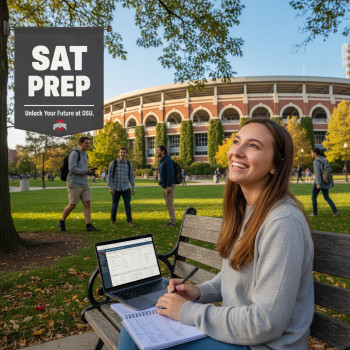Introduction: Yes — You Can Ace the Digital SAT, Even With a Strict Boarding Schedule
Living in a boarding school comes with predictable rhythms: lights-out rules, set meal times, mandatory study halls, and a schedule that’s often more regimented than a civilian teenager’s calendar. That structure can feel limiting when you’re trying to prepare for something as important and unpredictable as the Digital SAT. But here’s the truth: that structure can be your superpower.
This guide is a friendly, practical playbook for students who live on campus and want to use the boarding routine to boost their score—without burning out or sneaking extra study time in the dorm bathroom. We’ll cover realistic schedules, focused study techniques, how to make the most of supervised quiet hours, and ways to use weeknights and weekends strategically. You’ll also find examples, a simple planning table, and suggestions for images to help you visualize key moments. And when it makes sense, I’ll point out how Sparkl’s personalized tutoring and AI-driven insights can slot into your plan for extra momentum.
Why Boarding School Structure Can Help — If You Use It
On first glance, a strict schedule looks like a roadblock: you can’t always choose study times, and mandatory activities compete for your attention. But structure gives you something most students wish for—predictability. When your day is predictable, you can optimize the parts you control.
- Predictability reduces decision fatigue: You don’t waste brainpower debating when to study because certain blocks are already free or quiet.
- Built-in accountability: Study halls and resident advisors create natural checkpoints that keep you honest about your goals.
- Community learning: Boarding schools often bring motivated peers together—study buddies, math whizzes, and libraries just down the hall.
Quick mindset shift
Think of your schedule like a game board: the rules are fixed, but the strategy is yours. Instead of fighting boundaries, arrange your moves—short, focused study sessions, small daily wins, and deliberate weekend expansions—to create consistent progress.
Understand the Digital SAT Format (so you don’t waste time)
Before you plan, know what you’re preparing for. The Digital SAT has specific timing, adaptive sections, and a mix of reading, writing & language, and math content. You don’t need to memorize every detail here, but understanding the basic structure helps you prioritize practice (for example, whether you need targeted reading passages or timed math drills).
Study priority checklist
- Know the time limits and section types so your practice mimics test conditions.
- Identify weak areas (e.g., algebra vs. data analysis) and give them slightly more weekly time.
- Practice with full, timed digital tests occasionally so you build stamina and device familiarity.
Designing a Boarding-Friendly Weekly Plan
Here’s a schedule template that respects a typical boarding school routine: structured days, an evening lights-out window, and longer, freer weekends. Adjust the exact times to your school’s rules, but keep the idea of short daily sprints plus a longer weekly session.
| Day | Morning | Afternoon | Evening | Focus |
|---|---|---|---|---|
| Monday–Friday | 10–20 min vocab/flashcards before class | 30–40 min light practice after classes (in supervised study hall) | 1–1.5 hour targeted study session (if allowed) or review notes | Consistency — small, regular practice |
| Saturday | 1 hour practice test section (timed) | Review errors & concept drills | Relax and light review (30min) | Targeted test simulation |
| Sunday | Rest or light review | 2-hour focused study block (math or reading deep-dive) | Plan next week & quick flashcard session | Recharge + deep learning |
This template focuses on two principles: consistency and intensity. Short, consistent practice preserves energy during the school week; longer intensity sessions on the weekend build depth and stamina.
Daily Study Habits That Work in Tight Windows
When you have 30–60 minutes most evenings, make every minute count. Use study science: focus on active recall, short bursts, and deliberate practice.
Two study-session models
- Quick Sprint (20–30 minutes): Pick one concrete goal (e.g., 10 algebra questions, one reading passage). Warm-up 2 minutes, 18–25 minutes concentrated work, 2–5 minutes review of mistakes.
- Deep Shift (60–90 minutes): Warm-up 5 minutes, 45–60 minutes of mixed practice (timed passage or math set), 10–15 minutes focused review and note-taking.
Active techniques to maximize recall
- Self-testing: Try a question before looking at steps or answers.
- Explain out loud: Teach the concept to an imaginary classmate (or your roommate).
- Interleaving: Mix problem types rather than practicing only one type for an hour.
Use Boarding-Specific Opportunities
Boarding life has unique advantages — study halls, resident tutors, communal resources — that you should use intentionally.
Make study hall work for you
- Go in with a one-page plan: 5-minute warm-up, 20-minute focused practice, 5-minute review.
- Set concrete metrics: number of questions, pages, or minutes on a timed section.
- Use headphones with a neutral soundscape if allowed—helps maintain focus in a group setting.
Form a focused study group
Two or three peers who agree to a structure (no off-topic chat, rotating problem explainer) can turn social time into efficient study. Assign roles—timekeeper, explainer, error tracker—to keep sessions productive.
Weekend Plans: The Place for Test Simulations and Deep Work
Weekends are your secret weapon. With longer, flexible blocks, you can do full-length practice, review error patterns, and work on weaker domains.
Sample Saturday schedule for an effective deep day
- 09:00–10:20 — Full reading section or two practice modules (timed)
- 10:20–11:00 — Review mistakes, write down patterns
- 11:00–12:00 — Targeted practice (e.g., algebra or data interpretation)
- Afternoon — Light exercise; recharge
- Evening — 30-minute review and goal-setting for Sunday
How to Track Progress Without Getting Obsessed
Metrics are useful but dangerous if they become the only thing you care about. Track three things: accuracy patterns, timing patterns, and concept gaps. Then use short experiments to fix one pattern at a time.
Simple tracking table (example)
| Week | Section practiced | Common error type | Fix attempted | Outcome |
|---|---|---|---|---|
| Week 1 | Math — Algebra | Equation setup errors | Practice 10 setup-only problems daily | Improved setup accuracy by 40% |
| Week 2 | Reading | Detail questions | Highlight evidence sentences before answering | Reduced re-reads and time per question |
Keep the tracking simple. At the end of each week, ask: What’s one testable change I made? Did it help? If yes, keep it; if no, try something different.
Study Tools That Fit Boarding Life
Not every resource fits a strict daily routine. Look for portable, low-prep tools: short question sets, mobile-friendly apps, or tutoring that can be scheduled in small chunks. Here’s how to choose:
- Choose bite-sized practice that fits a 20–30 minute window.
- Use downloadable content for offline study (if internet is restricted in dorms).
- Prefer platforms that offer tailored practice based on your errors—this maximizes limited time.
Where Sparkl can fit naturally
If you’re looking for one-on-one guidance that adapts to a tight schedule, Sparkl’s personalized tutoring model can be an excellent fit. Short, focused sessions (even 30 minutes) with an expert tutor can quickly diagnose a recurring mistake and give a clear plan you can apply during study hall. Sparkl’s AI-driven insights help identify which small practice sets will produce the biggest score gains in the least time—perfect for boarding students juggling fixed commitments.
Handling Test-Day Simulations and Device Practice
The Digital SAT is delivered on devices, so part of practice should include device comfort: navigating the interface, using tools like highlighting or flagging, and managing screen fatigue.
Device practice checklist
- Take at least two full-length practice tests on the same device you’ll use for the test—ideally a larger device if allowed.
- Practice with the test’s digital tools: flagging, passage view, and answer review features.
- Simulate test-day conditions: no phone, timed sections, and the same snacks or break routine you plan to use.
Emotional and Physical Prep: Don’t Ignore the Basics
Strict schedules can cause stress. You need an emotional plan as much as a study plan. Sleep, movement, and micro-breaks are non-negotiable performance tools.
Simple wellbeing checklist
- Sleep: Protect at least 7 hours on weeknights if possible; aim for 8–9 on weekends when you can.
- Nutrition: Pack simple brain-food snacks (nuts, fruit, yogurt) for long practice days.
- Movement: Short walks or a 10-minute bodyweight routine can reset focus.
- Mindset: Use two-minute breathing or visualization before a full-length practice to settle nerves.
When and How to Ask for Extra Support
Boarding schools often offer academic support—tutors, teachers, or supervised study programs. Ask for what you need. Be specific: request help on a concept (like quadratic formulas or rhetorical analysis), not a vague “help me get better.”
How to make tutoring efficient
- Bring a one-page list of error patterns to each tutoring session.
- Ask the tutor to model a problem and then watch you explain it back—immediate feedback is powerful.
- Schedule sessions consistently, even if they’re short; regular check-ins produce steady gains.
Sparkl’s model of short, personalized sessions fits this perfectly: you can schedule 30–45 minute tutor check-ins that zero in on the week’s top two problem types, leaving you with a focused practice checklist for independent study.
Final Month Checklist: High-Leverage Actions
When the test is a few weeks away, pivot toward consolidation and confidence-building.
- Do two full practice tests on the device under simulated conditions—space them by a week.
- Switch to maintenance mode the week before: shorter practice sessions, review formula sheets, and light timing work.
- Review your tracking table: ensure you solved the two most persistent error patterns.
- Practice test-day routine: what you’ll eat, sleep schedule, and travel plans if needed.
Real Student Example: How One Boarding Student Turned Routine into Results
Sam (a fictional composite) lived in a boarding school with strict lights-out at 10:30 p.m. Sam used this plan:
- Weekdays: 25-minute study sprints after dinner during supervised study hall—focused on either a single math topic or one reading passage.
- Saturday: One timed section in the morning, then 45 minutes reviewing errors and diagramming why each mistake happened.
- Sunday: Longer, calmer two-hour block for targeted math practice and informal tutoring session with a resident tutor.
Within eight weeks, Sam tracked a steady reduction in careless mistakes and improved pacing. The consistent mini-sessions built endurance for full sections, and the weekend deep dives fixed conceptual weak spots. Short Sparkl tutoring sessions were scheduled twice in the cycle—once for a diagnostic and once two weeks before the test to cement strategy—helping Sam with targeted techniques that fit the boarding schedule.
Quick Troubleshooting: Common Boarding Challenges and Fixes
- Restricted evening hours: Move crucial practice to study hall and use flashcards in the morning.
- Limited device access: Download practice sets or use paper-based drills that match the Digital SAT question types.
- Loud dorm: Book the library or an empty classroom for a guaranteed quiet block.
- Procrastination in groups: Create a mini-contract with peers (15-minute warm-up, 30 minutes focused work, 10-minute recap).
Conclusion: Build Momentum with Small, Smart Steps
Preparing for the Digital SAT in a boarding school with strict schedules is not about finding more time—it’s about making better use of the time you already have. Short, consistent practice sprints during the week plus longer, strategic sessions on weekends create a rhythm that brings steady improvement. Use your boarding resources—study halls, peers, tutors—and layer in focused external help when needed. Sparkl’s personalized tutoring and AI-driven prioritization can plug into your life with short, high-impact sessions that respect your schedule and accelerate progress.
Remember: predictability is not a limitation; it’s a structure you can use to build confidence, sharpen skills, and walk into test day calm and ready. Pick one small change from this guide and try it this week. Small wins stack. Before you know it, your boarding-school routine won’t be an obstacle to your SAT goals—it’ll be the engine that drives them.














No Comments
Leave a comment Cancel